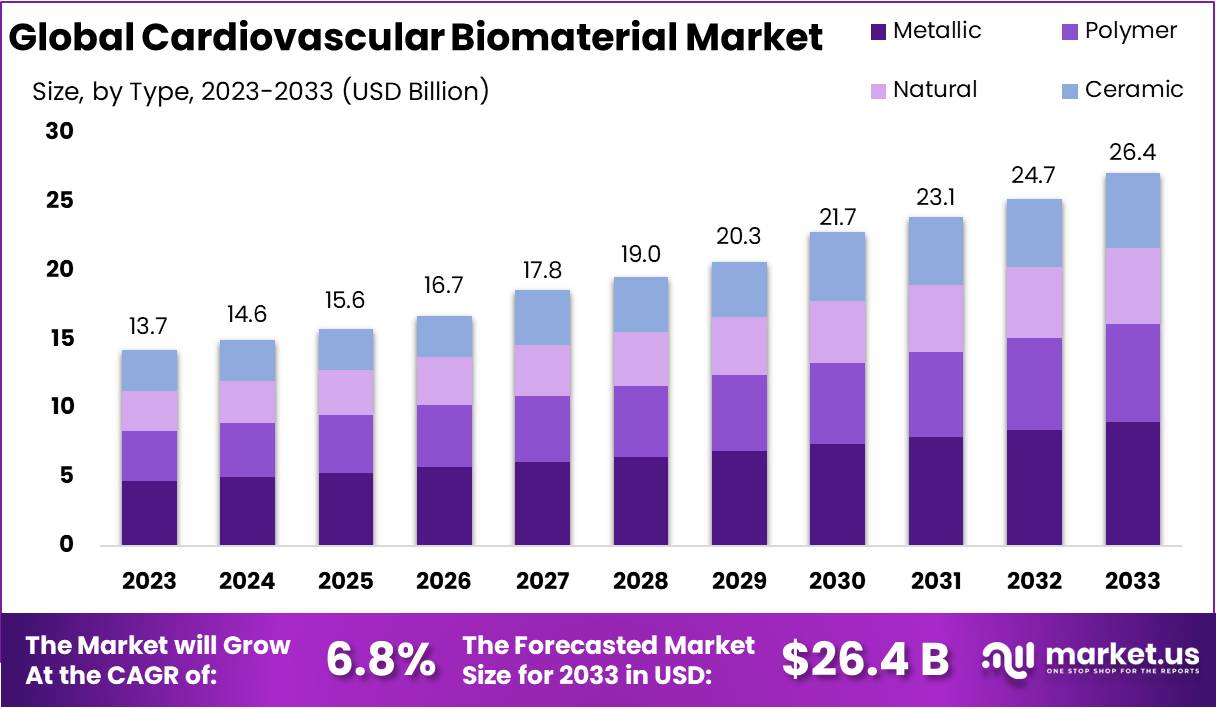Introduction
The Global Cardiovascular Biomaterial Market is projected to double in size from USD 13.7 billion in 2023 to approximately USD 26.4 billion by 2033, growing at a compound annual growth rate (CAGR) of 6.8%. This market expansion is driven by several factors, including advances in research and technological innovations. Key developments in angiogenesis, through the utilization of cytokines such as Vascular Endothelial Growth Factor (VEGF) and Basic Fibroblast Growth Factor-2 (FGF-2), are pivotal. These biomaterials aid in vascular growth and cellular repair, essential for developing new cardiovascular therapies.
Integration of genetic tools into cardiovascular health represents a significant stride forward. The Platelet Reactivity ExpreSsion Score (PRESS), for instance, leverages genetic signatures to assess platelet reactivity. This tool helps identify individuals at increased risk of cardiovascular events, enabling personalized treatment strategies. This genetic approach, combined with early interventions for lifestyle diseases like high cholesterol and hypertension, can significantly reduce cardiovascular disease risks from a young age.
The sector is also witnessing a surge in the use of innovative technologies and therapies. Wearable devices and gene editing are becoming integral in real-time health monitoring and offer therapeutic potentials for treating or preventing cardiovascular conditions through precise genetic modifications. These technologies are set to revolutionize cardiovascular healthcare by providing more personalized and effective treatment options.
Moreover, sustainable dietary practices are gaining traction as a preventive measure against cardiovascular diseases. Emphasizing a plant-based diet enriched with fruits, vegetables, and other plant foods has shown to decrease the risk of heart attacks and strokes. This nutritional shift not only promotes cardiovascular health but also aligns with broader health and wellness trends, influencing the market dynamics in the cardiovascular biomaterial sector.
The cardiovascular biomaterial market is poised for significant growth, fueled by advancements in biomaterial technology, genetic research, and innovative therapeutic practices. The shift towards personalized and preventive healthcare, coupled with the adoption of healthier lifestyle choices, underpins the evolving landscape of cardiovascular health management. These factors are crucial in reducing the global cardiovascular disease burden and are expected to drive the market’s expansion over the next decade.

Key Takeaways
- The Cardiovascular Biomaterial Market is projected to grow to USD 26.4 billion by 2033, with a CAGR of 6.8% from 2023.
- Metallic biomaterials are the leading type, comprising 34.1% of the market, prized for their superior properties.
- Stents are the most prevalent product, holding a 24.7% share, due to their effectiveness in cardiovascular procedures.
- The market encompasses various types like Natural, Ceramic, Metallic, and Polymer, and products like Catheters, Stents, and more.
- A significant driver is the global rise in cardiovascular diseases, causing over 17 million deaths annually, boosting demand for advanced biomaterials.
- Growth opportunities are bolstered by an aging global population and increased healthcare expenditure, enhancing the need for cardiovascular biomaterials.
- A shift towards biodegradable and minimally invasive cardiovascular biomaterials marks a significant emerging trend in the market.
- North America leads the market with a 41.5% share in 2023, supported by strong healthcare infrastructure and significant investments.
Regional Analysis
In 2023, North America led the Cardiovascular Biomaterial Market with a 41.5% share, valued at USD 5.6 billion. The region’s advanced healthcare infrastructure and robust investments in healthcare propelled this growth. North America’s focus on technological innovation and collaboration between academia, industry, and healthcare providers enhanced the integration of new biomaterials, establishing it as a global leader in the sector.
The high incidence of cardiovascular diseases due to aging populations and lifestyle changes increased the demand for innovative biomaterial solutions. Supportive government policies and favorable reimbursement conditions have spurred research and attracted key industry players, strengthening the market’s foundation.
North America is poised to maintain its market dominance thanks to continuous innovation and infrastructure enhancements. Ongoing research and a shift towards personalized healthcare solutions are likely to drive sustained growth and opportunities in the cardiovascular biomaterial market.
Key regions in the global landscape include the United States, Canada, Mexico in North America; Germany, France, and the UK in Western Europe; and China, Japan, and India in Asia-Pacific. Other notable regions include Brazil in Latin America and Saudi Arabia in the Middle East & Africa, each contributing to the diverse global market dynamics.
Emerging Trends
- Gene Therapy for Heart Disease: Recent breakthroughs in gene therapy offer new hope for treating cardiovascular diseases. Scientists are now developing treatments that target specific genetic anomalies, such as those found in the PCSK9 gene, which can lead to high levels of LDL cholesterol. By modifying these genes, these therapies can significantly lower cholesterol levels and reduce the risk of heart disease. This innovative approach demonstrates substantial promise in improving heart health.
- Advanced Biomanufacturing and Tissue Engineering: The field of biomanufacturing and tissue engineering is rapidly advancing with technologies like 3D bioprinting. This trend focuses on producing lab-grown tissues and organs, including hearts, kidneys, and blood vessels, from a patient’s own cells. Such developments are poised to alleviate the organ transplant shortage and lessen the reliance on donor organs, marking a significant step forward in medical treatment capabilities.
- Nanotechnology in Medicine: Nanotechnology is transforming the treatment of cardiovascular diseases through targeted drug delivery systems. Engineered nanoparticles can precisely target affected areas, enhancing treatment effectiveness while minimizing side effects. Additionally, nanomaterials are increasingly used in diagnostic processes to identify early-stage biomarkers of cardiovascular conditions, which is crucial for early intervention.
- Integration of Computational Tools: The integration of computational tools in cardiovascular research is becoming increasingly prevalent. Researchers utilize models and simulations to design and test new biomaterials efficiently. This approach accelerates the development cycle, moving innovations from the conceptual stage to clinical application more swiftly, thereby enhancing the potential for breakthroughs in patient care.
- Regenerative Medicine Approaches: Regenerative medicine is making strides in treating heart disease by using stem cells and growth factors to regenerate damaged heart tissue. This method holds the potential to revolutionize treatments for heart failure and other degenerative conditions by enabling the body to repair itself more effectively, offering a forward-thinking approach to long-term heart health management.
Use Cases
- Personalized Heart Valves: Tailored to individual patients, these heart valves are crafted from a combination of biomaterials and the patient’s own cells. This approach minimizes the risk of the body rejecting the implant and eliminates the need for lifelong immunosuppressive medications. By closely matching the patient’s biological profile, these valves enhance recovery and improve the overall quality of life after surgery.
- Drug-Eluting Stents: Biomaterials are at the forefront of developing stents that gradually release medication to prevent arteries from narrowing again after surgery. These stents offer dual benefits, they provide structural support to the artery and deliver drugs directly to the target area, reducing potential complications like thrombosis and restenosis, thereby enhancing patient outcomes.
- Biomaterials for Heart Repair: In cases of heart damage due to a myocardial infarction, biomaterials play a crucial role. They are used to deliver stem cells and growth factors directly to the affected areas of the heart. This treatment aids in repairing and regenerating heart tissue, ultimately improving the heart’s function and the patient’s recovery process.
- Wearable Diagnostic Devices: Advances in biomaterials have led to the development of wearable devices that are not only flexible and comfortable but also capable of continuously monitoring heart health. These devices detect any abnormalities at an early stage, helping to manage chronic conditions more effectively and prevent serious cardiovascular events. Their increasing use represents a significant shift towards proactive cardiovascular care.
Conclusion
The Global Cardiovascular Biomaterial Market is poised for robust growth, forecasted to reach approximately USD 26.4 billion by 2033. This surge is primarily fueled by technological advances and a deeper understanding of genetic markers in cardiovascular health. Innovations such as gene therapy and biomanufacturing are revolutionizing treatment approaches, making personalized and preventive care more accessible. Moreover, a focus on sustainable and healthy lifestyle choices is enhancing cardiovascular well-being on a broader scale. As the market continues to evolve, the integration of novel biomaterials and technologies is expected to significantly diminish the global burden of cardiovascular diseases, offering promising prospects for future healthcare solutions.
Discuss your needs with our analyst
Please share your requirements with more details so our analyst can check if they can solve your problem(s)



